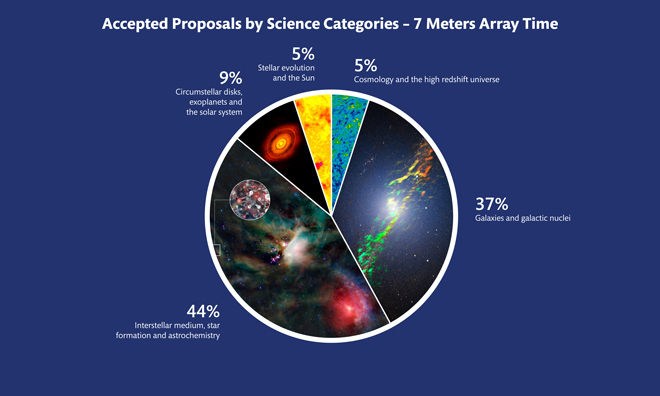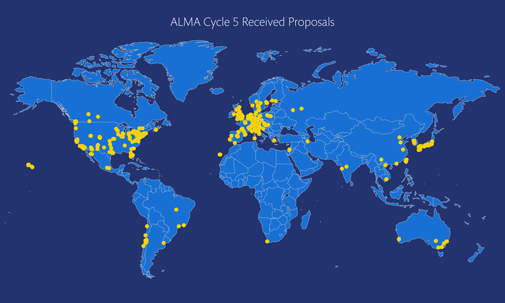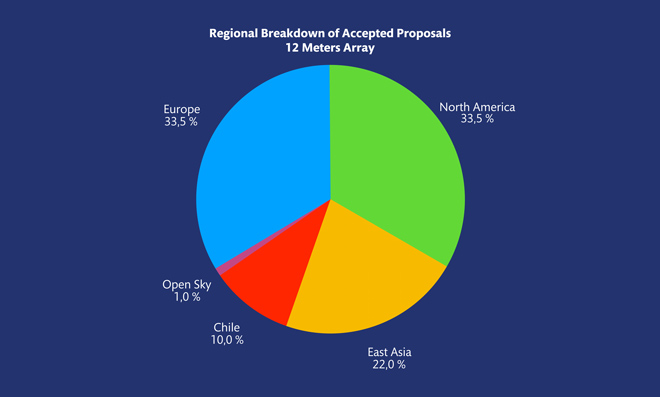ALMA is Almost Ready to Start Cycle 5 Observations
10 August, 2017 / Read time: 3 minutes
After notifying the over 1100 astronomers who were granted observation time with ALMA, a process that had taken nearly five months is finally ending. The ALMA Proposals Review Committee met last June in Antwerp, Belgium to evaluate the 1,661 proposals submitted from all around the world. This new observing cycle will begin in October 2017 with new capabilities available for the community.
“The 146 science reviewers are leading experts from all over the world in a very wide range of areas of astrophysics. Their contribution is essential to ensure that the evaluation process is as fair and objective as possible so that the observatory prioritizes the execution of the best and most relevant scientific projects,” says Gautier Mathys, the astronomer in charge of the coordination of the proposal selection process at ALMA. The scientific reviewers met for a week to establish a ranking of which proposals were likely to produce the most exciting results.
The category Interstellar Medium, Star Formation, and Astrochemistry received the most proposals submitted (422 of which 105 were selected); followed by Cosmology and the High Redshift Universe (386 submissions of which 100 were selected); Galaxies and Galactic Nuclei (354 proposals and 102 were selected); Circumstellar Disks, Exoplanets and the Solar System (354 submissions and 85 selected); and finally, Stellar Evolution and the Sun (145 submissions and 41 selected).
The regional distribution of the observation time for the 12-meters array is Europe 34%, North America 33%, East Asia 22%, Chile 10%, and Open Skies 1%. The same distribution for the Atacama Compact Array is 25% Europe, 36% for North America, 29% East Asia and 10% Chile.

ALMA Cycle 5 main new capabilities. Credit: ALMA (ESO/NAOJ/NRAO) | Download image


Breakdown of ALMA Cycle 5 accepted proposals by science category. Credits: Composition: ALMA (ESO/NAOJ/NRAO) | Background images: The Sun – ALMA (ESO/NAOJ/NRAO) · CMB – NASA / WMAP Science Team · Astrochemistry – ESO/L. Calçada & NASA/JPL-Caltech/WISE Team · Centaurus A – ALMA (ESO/NAOJ/NRAO); Y. Beletsky (LCO)/ESO · HL Tau – ALMA (ESO/NAOJ/NRAO) | Download image
Cycle 5 observations will begin in October 2017 and will end on September 2018 with at least 56 antennas available. The 433 proposals selected will have access to explore the Universe at millimeter and submillimeter wavelengths using eight receivers: Bands 3, 4, 6, 7, 8, 9, 10, and, for the first-time, Band 5. During this cycle, ALMA will achieve an angular resolution as fine as 0.018 arcseconds using a 16-kilometer maximum baseline.

This map shows the location from which each observation proposal was submitted. Credit: ALMA (ESO/NAOJ/NRAO) | Download image

The science advisors of the ALMA Proposal Review Committee gathered in Antwerp, Belgium. Credit: ALMA (ESO/NOAJ/NRAO) | Download image


Breakdown of the accepted proposals by regions. Credit: ALMA (ESO/NAOJ/NRAO) | Download image
Additional information
ALMA is a partnership of ESO (representing its member states), NSF (USA) and NINS (Japan), together with NRC (Canada), NSC and ASIAA (Taiwan), and KASI (Republic of South Korea), in cooperation with the Republic of Chile. The Joint ALMA Observatory is operated by ESO, AUI/NRAO, and NAOJ.
Contacts
-
Nicolás Lira
Education and Public Outreach Coordinator
Joint ALMA Observatory, Santiago - Chile
Phone: +56 2 2467 6519
Cel: +56 9 9445 7726
Email: [email protected]
